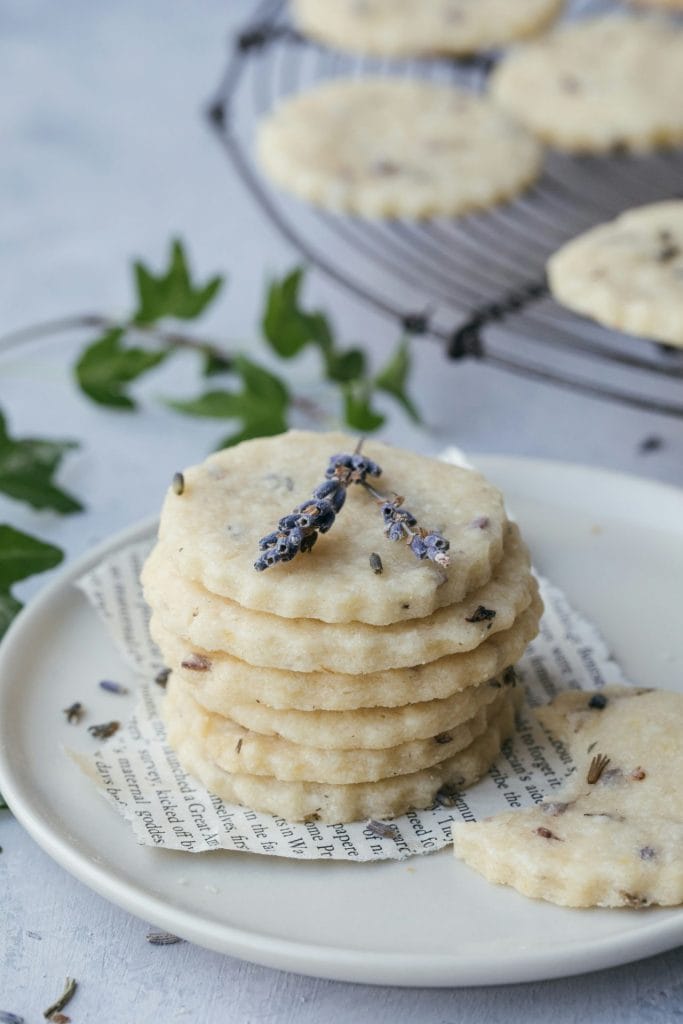
Lavender is such a garden classic and nowadays found in SO MANY THINGS. I’ve been getting questions on growing lavender so wanted to dive into it! I’d say that lavender is the plant most associated with calm, sleep, and babies. However, my mother is very allergic to lavender (her throat closes!), and it can mimic estrogen in the body, which can cause some issues, so it’s not the magical unicorn that we all think it is. However, we also do love our lav for so many reasons.

The 5 Main Lavender Cultivars:
The five main types of lavender plants, also known as lavender cultivars or species, are English lavender (Lavandula angustifolia), French lavender (Lavandula stoechas), Spanish lavender (Lavandula dentata), Lavandin (Lavandula x intermedia), and Fernleaf lavender (Lavandula multifida).
1. English Lavender (Lavandula angustifolia): This is the most common and widely grown lavender. It is known for its sweet fragrance and compact growth habit. English lavender is great for culinary use, drying, and making lavender oil or sachets.
2. French Lavender (Lavandula stoechas): French lavender features distinctive floral bracts on top of the flower spikes, which resemble “rabbit ears.” It has a strong, sweet fragrance. While it can be used in cooking sparingly, its strong scent makes it better suited for ornamental purposes.
3. Spanish Lavender (Lavandula dentata): Spanish lavender is known for its serrated leaves and unique butterfly-like blooms. It has a strong, piney fragrance and is good for cutting and drying due to its ability to hold its color well.
4. Lavandin (Lavandula x intermedia): Lavandin is a hybrid lavender resulting from crossing English and Portuguese lavender. It is valued for its high oil content and intense fragrance. Lavandin is commonly used for producing essential oils and has a strong scent.
5. Fernleaf Lavender (Lavandula multifida): Fernleaf lavender has delicate, feathery leaves and bright purple flowers. It has a unique, resinous fragrance and adds a beautiful texture to gardens. While it can be used for culinary purposes, it is primarily grown for ornamental uses due to its appearance.
When it comes to culinary use, English lavender is the best choice. Its sweet and floral fragrance adds an excellent aroma to various dishes and desserts. For drying purposes, Spanish lavender is a preferred option, as it retains its color and shape during the drying process. Lastly, for fragrance and essential oil production, both Lavandin and English lavender are commonly selected due to their strong scents and high oil content.

Growing Lavender
Lavender is so lovely in that she can be a perennial and can even be used as a hedge in some climates! She is quite drought tolerant and does not like to be overly wet, so keep that in mind.
1. Choose the right variety: Use the above guide to choose which type of lavender you want to grow.
2. Location: Lavender prefers full sun, so choose a spot in your garden that receives at least 6-8 hours of direct sunlight daily. Ensure that the soil is well-draining to prevent root rot, as lavender dislikes excessive moisture.
3. Planting: Lavender can be grown from seeds, cuttings, or purchased plants. If starting from seeds, sow them indoors 8-10 weeks before the last frost date. Transplant young plants or seedlings after the last frost date in spring. Space them about 12-24 inches apart to allow air circulation.
4. Soil: Lavender thrives in slightly alkaline soil with a pH of 6.5 to 7.5. Improve soil drainage by adding sand or gravel to the planting area. If your soil is heavy or clay-like, consider creating raised beds or growing lavender in containers.
5. Watering: Lavender is drought-tolerant once established, so avoid over-watering. Water deeply but infrequently, allowing the soil to dry out slightly between watering sessions. During the first season, young plants will require more regular watering until their roots are well-established.
6. Pruning: Prune lavender annually to maintain a compact shape and encourage bushier growth. In early spring, remove any dead or damaged branches. After flowering, lightly trim down about one-third of the plant’s height, being careful not to cut into old wood where new growth won’t readily occur.
7. Fertilizing: Lavender generally doesn’t require much fertilizer. If needed, apply a slow-release, balanced granular fertilizer once a year, preferably in spring when new growth emerges. Be cautious not to over-fertilize, as this can lead to excessive leaf growth at the expense of blooms.
8. Pests and diseases: Lavender is relatively resistant to pests and diseases, particularly due to its fragrant oil. However, be mindful of root rot caused by overly wet soil. Additionally, common pests like aphids or spider mites may occasionally infest lavender. In such cases, insecticidal soaps or neem oil can help control them.
By following these guidelines, you’ll be on your way to growing and caring for beautiful and fragrant lavender plants!

Lavender in Cooking
While lavender can be used in so many ways, let’s explore a few culinary options. Lavender syrup is a fan favorite around here, adding a gentle garden touch to our lattes and baked goods.
1. Lavender-infused honey: Combine honey and dried lavender buds in a jar, and let it sit for a week. Use this floral-infused honey as a unique sweetener in teas, baked goods, or drizzle it over desserts.
2. Lavender lemonade: Add a few sprigs of fresh or dried lavender to your homemade lemonade to give it a fragrant and refreshing twist.
3. Lavender shortbread cookies: Incorporate dried lavender buds into your favorite shortbread cookie recipe for a delicate floral flavor. Garnish with a sprinkle of lavender on top before baking.
4. Lavender vanilla cupcakes: Infuse your vanilla cupcake batter with a couple of teaspoons of culinary lavender for a sophisticated and aromatic twist. Top it off with lavender frosting or a lavender glaze.
5. Lavender-roasted chicken: Rub a mixture of dried lavender buds, minced garlic, olive oil, salt, and pepper onto a whole chicken before roasting it. The lavender adds a subtle floral aroma to the dish.
6. Lavender-infused cream or milk: Steep a few sprigs of fresh lavender in cream or milk and use it in recipes like custards, ice cream, or panna cotta. The lavender infusion adds an elegant touch.
7. Lavender syrup: Make a simple syrup by boiling equal parts water and sugar, and then infuse it with dried lavender buds. This syrup can be used to flavor cocktails, lemonades, sparkling water, or even drizzled over pancakes or waffles.
8. Lavender salad dressing: Add a fragrant twist to your vinaigrette by mixing dried lavender buds with olive oil, balsamic vinegar, Dijon mustard, honey, salt, and pepper. Use it to dress crisp salads for a unique flavor.
9. Lavender-infused butter: Whip softened butter with a small amount of dried culinary lavender and a pinch of salt. Use this fragrant butter to spread on warm bread, melt over grilled vegetables, or cook with seafood.
10. Lavender ice cream: Infuse a custard base with dried lavender buds and strain before churning. The resulting ice cream will have a subtle floral note that pairs wonderfully with berries or dark chocolate.
Remember, when cooking with lavender, always use culinary lavender specifically labeled for consumption, as other lavender varieties may taste soapy or overly strong.
I hope you enjoy this deep dive into growing and using lavender – let me know which subject to tackle next in the comments.
